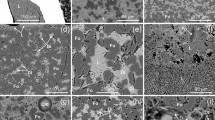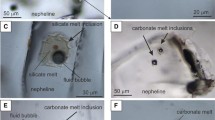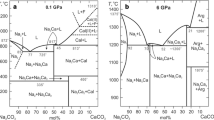Abstract
To explore the effect of bulk composition on the solidus of carbonated eclogite, we determined near-solidus phase relations at 3 GPa for four different nominally anhydrous, carbonated eclogites. Starting materials (SLEC1, SLEC2, SLEC3, and SLEC4) were prepared by adding variable proportions and compositions of carbonate to a natural eclogite xenolith (66039B) from Salt Lake crater, Hawaii. Near-solidus partial melts for all bulk compositions are Fe–Na calcio-dolomitic and coexist with garnet + clinopyroxene + ilmenite ± calcio-dolomitic solid solution. The solidus for SLEC1 (Ca#=100 × molar Ca/(Ca + Mg + FeT)=32, 1.63 wt% Na2O, and 5 wt% CO2) is bracketed between 1,050°C and 1,075°C (Dasgupta et al. in Earth Planet Sci Lett 227:73–85, 2004), whereas initial melting for SLEC3 (Ca# 41, 1.4 wt% Na2O, and 4.4 wt% CO2) is between 1,175°C and 1,200°C. The solidus for SLEC2 (Ca# 33, 1.75 wt% Na2O, and 15 wt% CO2) is estimated to be near 1,100°C and the solidus for SLEC3 (Ca# 37, 1.47 wt% Na2O, and 2.2 wt% CO2) is between 1,100°C and 1,125°C. Solidus temperatures increase with increasing Ca# of the bulk, owing to the strong influence of the calcite–magnesite binary solidus-minimum on the solidus of carbonate bearing eclogite. Bulk compositions that produce near-solidus crystalline carbonate closer in composition to the minimum along the CaCO3-MgCO3 join have lower solidus temperatures. Variations in total CO2 have significant effect on the solidus if CO2 is added as CaCO3, but not if CO2 is added as a complex mixture that maintains the cationic ratios of the bulk-rock. Thus, as partial melting experiments necessarily have more CO2 than that likely to be found in natural carbonated eclogites, care must be taken to assure that the compositional shifts associated with excess CO2 do not unduly influence melting behavior. Near-solidus dolomite and calcite solid solutions have higher Ca/(Ca + Mg) than bulk eclogite compositions, owing to Ca–Mg exchange equilibrium between carbonates and silicates. Carbonates in natural mantle eclogite, which have low bulk CO2 concentration, will have Ca/Mg buffered by reactions with silicates. Consequently, experiments with high bulk CO2 may not mimic natural carbonated eclogite phase equilibria unless care is taken to ensure that CO2 enrichment does not result in inappropriate equilibrium carbonate compositions. Compositions of eclogite-derived carbonate melt span the range of natural carbonatites from oceanic and continental settings. Ca#s of carbonatitic partial melts of eclogite vary significantly and overlap those of partial melts of carbonated lherzolite, however, for a constant Ca-content, Mg# of carbonatites derived from eclogitic sources are likely to be lower than the Mg# of those generated from peridotite.










Similar content being viewed by others
References
Adam J, Green T (2001) Experimentally determined partition coefficients for minor and trace elements in peridotite minerals and carbonatitic melt, and their relevance to natural carbonatites. Eur J Miner 13:815–827. DOI 10.1127/0935-1221/2001/0013/0815
Alt JC, Teagle DAH (1999) The uptake of carbon during alteration of ocean crust. Geochim Cosmochim Acta 63:1527–1535. DOI 10.1016/S0016-7037(99)00123-4
Baker MB, Stolper EM (1994) Determining the composition of high-pressure mantle melts using diamond aggregates. Geochim Cosmochim Acta 58:2811–2827. DOI 10.1016/0016-7037(94)90116-3
Bell K, Tilton GR (2001) Probing the mantle: the story from carbonatites. EOS, Trans Am Geophys Un 83:273–277
Berner RA (1999) A new look at the long-term carbon cycle. GSA Today 9:1–6
Blundy J, Dalton J (2000) Experimental comparison of trace element partitioning between clinopyroxene and melt in carbonate and silicate systems, and implications for mantle metasomatism. Contrib Miner Petrol 139:356–371. DOI 10.1007/s004100000139
Brenan JM, Watson EB (1991) Partitioning of trace elements between carbonate melt and clinopyroxene and olivine at mantle P-T conditions. Geochim Cosmochim Acta 55:2203–2214. DOI 10.1016/0016-7037(91)90097-O
Byrnes AP, Wyllie PJ (1981) Subsolidus and melting relations for the join CaCO3-MgCO3 at 10 kb. Geochim Cosmochim Acta 45:321–328. DOI 10.1016/0016-7037(81)90242-8
Canil D (1990) Experimental study bearing on the absence of carbonate in mantle-derived xenoliths. Geology 18:1011–1013
Canil D, Scarfe CM (1990) Phase relations in peridotite + CO2 systems to 12 GPa: implications for the origin of kimberlite and carbonate stability in the Earth’s upper mantle. J Geophys Res 95:15805–15816
Coltice N, Simon L, Lécuyer C (2004) Carbon isotope cycle and mantle structure. Geophys Res Lett 31:L05603. DOI 10.1029/2003Gl018873
Dalton JA, Presnall DC (1998) Carbonatitic melts along the solidus of model lherzolite in the system CaO-MgO-Al2O3-SiO2-CO2 from 3 to 7 GPa. Contrib Miner Petrol 131:123–135. DOI 10.1007/s00410050383
Dalton JA, Wood BJ (1993a) The compositions of primary carbonate melt and their evolution through wallrock reaction in the mantle. Earth Planet Sci Lett 119:511–525. DOI 10.1016/0012-821X(93)90059-I
Dalton JA, Wood BJ (1993b) The partitioning of Fe and Mg between olivine and carbonate and the stability of carbonate under mantle conditions. Contrib Miner Petrol 114:501–509
Dasgupta R, Hirschmann MM, Withers AC (2004) Deep global cycling of carbon constrained by the solidus of anhydrous, carbonated eclogite under upper mantle conditions. Earth Planet Sci Lett 227:73–85. DOI 10.1016/j.epsl.2004.08.004
Deines P, Harris JW, Gurney JJ (1987) Carbon isotopic composition, nitrogen content and iclusion composition of diamonds from the Roberts Victor kimberlite, South Africa: evidence for 13C depletion in the mantle. Geochim Cosmochim Acta 51:1227–1243. DOI 10.1016/0016-7037(87)90215-8
Ellis DJ, Green DH (1979) An experimental study of the effect of Ca upon garnet-clinopyroxene Fe-Mg exchange equilibria. Contrib Miner Petrol 71:13–22
Falloon TJ, Green DH (1989) The solidus of carbonated, fertile peridotite. Earth Planet Sci Lett 94:364–370. DOI 10.1016/0012-821X(89)90153-2
Hammouda T (2003) High-pressure melting of carbonated eclogite and experimental constraints on carbon recycling and storage in the mantle. Earth Planet Sci Lett 214:357–368. DOI 10.1016/S0012-821X(03)00361-3
Hirose K (1997) Melting experiments on lherzolite KLB-1 under hydrous conditions and generation of high-magnesian andesitic melts. Geology 25:42–44. DOI 10.1130/0091-7613(1997)025<0042:MEOLKU>2.3.CO;2
Hirose K, Kushiro I (1993) Partial melting of dry peridotites at high pressure: determination of compositions of melts segregated from peridotites using aggregates of diamonds. Earth Planet Sci Lett 114:477–489 DOI 10.1016/0012-821X(93)90077-M
Hirschmann MM (2000) The mantle solidus: experimental constraints and the effect of peridotite composition. Geochem Geophys Geosys 1:2000GC000070
Hirschmann MM, Stolper EM (1996) A possible role of garnet pyroxenite in the origin of the “garnet signature” in the MORB. Contrib Miner Petrol 124:185–208 DOI 10.1007/s004100050184
Hoernle K, Tilton G, Bas MJL, Duggen S, Schönberg DG (2002) Geochemistry of oceanic carbonatites compared with continental carbonatites: mantle recycling of oceanic crustal carbonate. Contrib Miner Petrol 142: 520–542 DOI 10.1007/s004100100308
Irving AJ, Wyllie PJ (1975) Subsolidus and melting relationships for calcite, magnesite and the join CaCO3-MgCO3 to 36 kb. Geochim Cosmochim Acta 39:35–53. DOI 10.1016/0016-7037(75)90183-0
Jarosewich E, Nelen JA, Norberg JA (1980) Reference samples for electron microprobe analysis. Geostand Newslett 4:43–47
Javoy M (1997) The major volatile elements of the Earth: their origin, behavior, and fate. Geophys Res Lett 24:177–180
Kawamoto T, Holloway JR (1997) Melting temperature and partial melt chemistry of H2O-saturated mantle peridotite to 11 Gigapascals. Science 276:240–243. DOI 10.1126/science.276.5310.240
Kerrick DM (2001) Present and past nonanthropogenic CO2 degassing from the solid earth. Rev Geophys 39:565–585
Kerrick DM, Connolly JAD (2001) Metamorphic devolatilization of subducted oceanic metabasalts: implications for seismicity, arc magmatism and volatile recycling. Earth Planet Sci Lett 189:19–29. DOI 10.1016/S0012-821X(01)00347-8
Klemme S, van der Laan SR, Foley SF, Günther D (1995) Experimentally determined trace and minor elements partitioning between clinopyroxene and carbonatite melt under upper mantle conditions. Earth Planet Sci Lett 133:439–448. DOI 10,1016/0012-821X(95)00098-W
Knoche R, Sweeney RJ, Luth RW (1999) Carbonation and decarbonation of eclogite: the role of garnet. Contrib Miner Petrol 135:332–339. DOI 10.1007/s004100050515
Kogiso T, Hirschmann MM, Pertermann M (2004) High pressure partial melting of mafic lithologies in the mantle. J Petrol 45:2407–2422. DOI 10.1093/petrology/egh057
Le Maitre RW (1989) A classification of igneous rocks and glossary of terms. Blackwell, Oxford
Lee WJ, Huang, WL, Wyllie, P (2000) Melts in the mantle modeled in the system CaO-MgO-SiO2-CO2 at 2.7 GPa. Contrib Miner Petrol 138:199–213. DOI 10.1007/s004100050557
Liou JG, Zhang RY, Ernst WG, Rumble D, Maruyama S (1998) High-pressure minerals from deeply subducted metamorphic rocks. In: Hemley RJ (ed) Ultrahigh-pressure mineralogy, Rev Mineral, vol 37. Mineralogical Society of America, Washington DC, pp 33–96
Luth RW (1995) Experimental determination of the reaction dolomite + 2coesite=diopside + 2CO2 to 6 GPa. Contrib Miner Petrol 122:152–158. DOI 10.1007/s004100050118
Luth RW (1999) Carbon and carbonates in the mantle. In: Fei Y, Bertka CM, Mysen BO (eds) Mantle petrology: field observations and high pressure experimentation: a tribute to Francis R. (Joe) Boyd. The Geochemical Society, Washington, pp 297–316
Manning CE (2004) The chemistry of subduction-zone fluids. Earth Planet Sci Lett 223:1–16. DOI 10.1016/j.epsl.2004.04.030
Martinez I, Perez EMC, Matas J, Gillet P, Vidal G (1998) Experimental investigation of silicate-carbonate system at high pressure and high temperature. J Geophys Res 103:5143–5163
Molina JF, Poli S (2000) Carbonate stability and fluid composition in subducted oceanic crust: an experimental study on H2O-CO2-bearing basalts. Earth Planet Sci Lett 176:295–310. DOI 10.1016/S0012-821X(00)00021-2
Pertermann M, Hirschmann MM (2003) Anhydrous partial melting experiments on MORB-like eclogite: phase relations, phase compositions and mineral-melt partitioning of major elements at 2–3 GPa. J Petrol 44:2173–2201. DOI 10.1093/petrology/egg074
Pickering-Witter J, Johnston AD (2000) The effects of variable bulk composition on melting systematics of fertile peridotitic assemblages. Contrib Mineral Petrol 140:190–211. DOI 10.1007/s004100000183
Ravna EK (2000) The garnet-clinopyroxene Fe2+ -Mg geothermometer: an updated calibration. J Met Geol 18:211–219. DOI 10.1046/j.1525-1314.2000.00247.x
Robinson JAC, Wood BJ, Blundy JD (1998) The beginning of melting of fertile and depleted peridotite. Earth Planet Sci Lett. 155:97–111. DOI 10.1016/S0012-821X(97)00162-3
Ryabchikov ID, Brey G, Kogarko LN, Bulatov VK (1989) Partial melting of carbonatized peridotite at 50 kbar. Geokhimiya 1:3–9
Sasada T, Hiyagon H, Bell K, Ebihara M (1997) Mantle-derived noble gases in carbonatites. Geochim Cosmochim Acta 61: 4219–4228. DOI 10.1016/S0016-7037(97)00202-0
Schwab BE, Johnston AD (2001) Melting systematics of modally variable, compositionally intermediate peridotites and the effects of mineral fertility. J Petrol 42:1789–1811. DOI 10.1093/petrology/12.10.1789
Sleep NH, Zahnle K (2001) Carbon dioxide cycling and implications for climate on ancient earth. J Geophys Res 106:1373–1399
Spandler C, Hermann J, Arculus R, Mavrogenes J (2004) Geochemical heterogeneity and element mobility in deeply subducted oceanic crust: insights from high-pressure mafic rocks from New Caledonia. Chem Geol 206:21–42. DOI 10.1016/j.chemgeo.2004.01.006
Staudigel J, Plank T, White B, Schmincke HU (1996) Geochemical fluxes during seafloor alteration of the basaltic upper oceanic crust: DSDP sites 417 and 418. In: Bebout GE, Scholl DW, Kirby SH, Platt JP (eds) Subduction, top to bottom. American Geophysical Union, Washington, pp 19–38
Sweeney RJ (1994) Carbonatite melt compositions in the Earth’s mantle. Earth Planet Sci Lett 128:259–270. DOI 10.1016/0012-821X(94)90149-X
Sweeney RJ, Prozesky V, Przybylowicz W (1995) Selected trace and minor element partitioning between peridotite minerals and carbonatite melts at 18–46 kb pressure. Geochim Cosmochim Acta 59:3671–3683. DOI 10.1016/S0016-7047(95)00270-A
Thibault Y, Edgar AD, Lloyd FE (1992) Experimental investigation of melts from a carbonated phlogopite lherzolite: Implications for metasomatism in the continental lithospheric mantle. Am Miner 77:784–794
Thompson RN, Smith PM, Gibson SA, Mattey DP, Dickin AP (2002) Ankerite carbonatite from Swartbooisdrif, Namibia: the first evidence of magmatic ferrocarbonatite. Contrib Miner Petrol 143:377–395. DOI 10.1007/s00410-002-0350-0
Ulmer P, Sweeney RJ (2002) Generation and differentiation of group II kimberlites: constraints from a high-pressure experimental study to 10 GPa. Geochim Cosmochim Acta 66:2139–2153. DOI 10.1016/S0016-7037(02)00898-0
Wallace ME, Green DH (1988) An experimental determination of primary carbonatite magma composition. Nature 335:343–346
Wasylenki LE, Baker MB, Kent, AJR, Stolper EMS (2003) Near solidus melting of the shallow upper mantle: partial melting experiments on depleted peridotite. J Petrol 44:1163–1191. DOI 10.1093/petrology/44.7.1163
Woolley AR, Kempe DRC (1989) Carbonatites: nomenclature, average chemical compositions, and element distribution. In: Bell K (ed) Carbonatites: genesis and evolution. Unwin Hyman, London, pp 1–14
Wyllie PJ (1979) Magmas and volatile components. Am Miner 64:469–500
Wyllie PJ, Huang W-L (1976) Carbonation and melting reactions in the system CaO-MgO-SiO2-CO2 at mantle pressures with geophysical and petrological applications. Contrib Miner Petrol 54:79–107
Xirouchakis D, Hirschmann MM, Simpson J (2001) The effect of titanium on the silica content and on mineral-liquid partitioning of mantle-equilibrated melts. Geochim Cosmochim Acta 65:2201–2217. DOI 10.1016/S0016-7037(00)00549-4
Yaxley GM, Brey GP (2004) Phase relations of carbonate-bearing eclogite assemblages from 2.5 to 5.5 GPa: implications for petrogenesis of carbonatites. Contrib Miner Petrol 146:606–619. DOI 10.1007/s00410-003-0517-3
Yaxley GM, Green DH (1994) Experimental demonstration of refractory carbonate-bearing eclogite and siliceous melt in the subduction regime. Earth Planet Sci Lett 128:313–325. DOI 10.1016/0012-821X(94)90153-8
Yaxley GM, Green DH (1996) Experimental reconstruction of sodic dolomitic carbonatite melts from metasomatised lithosphere. Contrib Miner Petrol 124:359–369. DOI 10.1007/s004100050196
Yaxley GM, Green DH, Klapova H (1994) The refractory nature of carbonate during partial melting of eclogite: evidence from high pressure experiments and natural carbonate-bearing eclogites. Min Mag 58A:996–997
Acknowledgements
We gratefully acknowledge constructive reviews by Robert Luth and Greg Yaxley. R.D. thanks Cyril Aubaud and Anthony Withers for useful discussions and comments during preparation of the manuscript. R.D. also acknowledges support from V.R. Murthy and J. Noruk fellowship of the Department of Geology and Geophysics, University of Minnesota and Doctoral Dissertation Fellowship from the Graduate School of University of Minnesota. This work supported by National Science Foundation grant EAR-0310142 to M.M.H. N.D.’s internship at Minnesota was funded through University of Minnesota’s Geology and Geophysics REU site, National Science Foundation grant EAR-0243526.
Author information
Authors and Affiliations
Corresponding author
Rights and permissions
About this article
Cite this article
Dasgupta, R., Hirschmann, M.M. & Dellas, N. The effect of bulk composition on the solidus of carbonated eclogite from partial melting experiments at 3 GPa. Contrib Mineral Petrol 149, 288–305 (2005). https://doi.org/10.1007/s00410-004-0649-0
Received:
Accepted:
Published:
Issue Date:
DOI: https://doi.org/10.1007/s00410-004-0649-0




